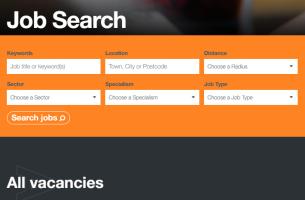
Gary Robinson
Oct 25, 2025
Warehouse capacity constraints: Space, Automation, and the Talent Challenge
As the year unfolds, the warehouse and logistics sector across the eastern and central United States is under continued pressure, not just for operational efficiency, but for skilled talent, too. While industrial vacancy has risen from the record lows seen during the pandemic boom, modern, high-spec warehouse space remains in short supply.
The result? Companies are rethinking warehouse strategy, investing in automation, and competing fiercely for the people who can make it all work.
The Space Equation: Scarcity Has Shifted, Not Disappeared
After years of extraordinary demand, the U.S. industrial vacancy rate has increased from its historic low of about 2.8% in mid-2022 to around 6.5–7.1% in 2025 (according to Cushman & Wakefield, CBRE, and JLL). While that might suggest some breathing room, the reality is more complex - many of those vacancies are in older or less well-located facilities, while modern, automation-ready warehouses near ports, highways, and major population centers are still hard to secure.
As a result, companies in regions such as the Northeast Corridor, the Midwest logistics belt, and the Southeast distribution hubs are under growing pressure to do more with the space they already have.
That means redesigning layouts, using high-density storage systems, and investing in smarter warehouse management technology to squeeze more efficiency from every square foot.
This shift is changing what employers need from their teams. Traditional warehouse experience remains valuable, but now there’s a premium on analytical thinking, systems knowledge, and comfort with data-driven decisions. Operations managers who can analyze workflows, redesign floor plans, and apply lean principles are increasingly in demand.
Automation and the Expanding Skills Gap
Automation is no longer an optional upgrade, it’s a strategic requirement. Robotics, AI-powered inventory tools, and IoT-connected sensors are transforming warehouse operations across the country. But the real challenge isn’t buying the technology it’s finding people who can make it work.
Employers are facing intense competition for warehouse automation specialists, robotics engineers, and operations leaders with digital integration expertise. Managers who can bridge the gap between traditional operations and advanced technologies (especially those experienced with robotics and IoT integration) are among the hardest to recruit.
Many are broadening their searches, drawing from manufacturing, aerospace, or IT sectors to access candidates with transferable technical skills. This cross-sector recruitment trend reflects a growing realization - future warehouse performance depends as much on engineering and data fluency as it does on logistics know-how.
Cross-training: The key to retention and resilience
With technology advancing faster than the talent pool can grow, many organizations are turning inward to build capability. Cross-training and internal upskilling have become essential strategies for retention and long-term resilience.
Professionals advancing their expertise in automation strategy and robotics integration, leaders are deepening their knowledge of data analytics and process optimization, and senior executives are focusing on AI-driven decision-making (a theme we explore further in our blog on how to interview for AI awareness). Consequently, employers who invest in their people not only fill skills gaps, they also improve engagement and loyalty - a crucial advantage in a market where turnover remains high.
What this means for employers
To stay competitive, businesses need to take a holistic approach to warehouse & distribution strategy. That means balancing technological development with proactive talent planning. Key priorities include;
- Assessing current space utilization and exploring data-driven optimization tools before committing to costly expansion.
- Building partnerships with higher educational facilities and training providers to create a pipeline of automation-ready talent.
- Upskilling existing teams through structured internal programs focused on digital systems, and lean operations.
- Offering competitive compensation and clear career progression to attract and retain top-tier operational and engineering talent.
Warehouse capacity constraints are forcing companies to innovate - not just in how they use space, but in how they build teams. The winners will be those that combine smarter physical strategies with smarter people strategies, blending technology, data, and human expertise to achieve peak efficiency in an increasingly constrained environment.
At Cast USA, we’re seeing a clear shift in what employers need at the mid and senior management level. Operations Directors, Engineering Managers, and Continuous Improvement Leaders with hands-on experience in automation integration, digital transformation, and data-led decision-making are in particularly high demand.
Many organizations are also prioritizing managers who can lead cross-functional teams through change, blending traditional warehouse operations expertise with forward-looking technology strategies. As competition for these hybrid skill sets intensifies, proactive succession planning and targeted leadership recruitment are becoming essential to long-term success.
Looking to strengthen your warehouse leadership team?
Cast USA connects employers with exceptional mid- and senior-level talent across logistics, operations, and automation. Contact us to learn how we can help you build the skills your business needs for the future.


